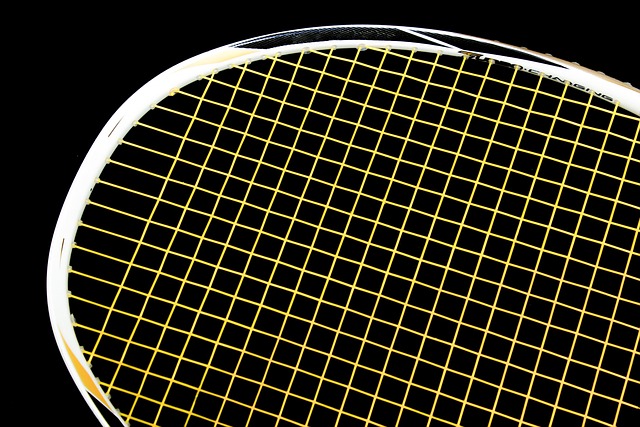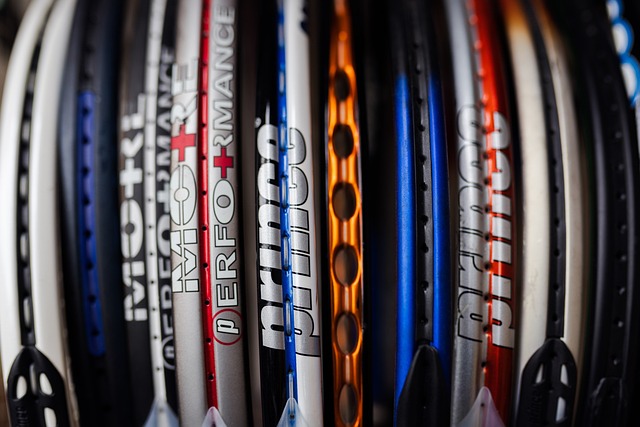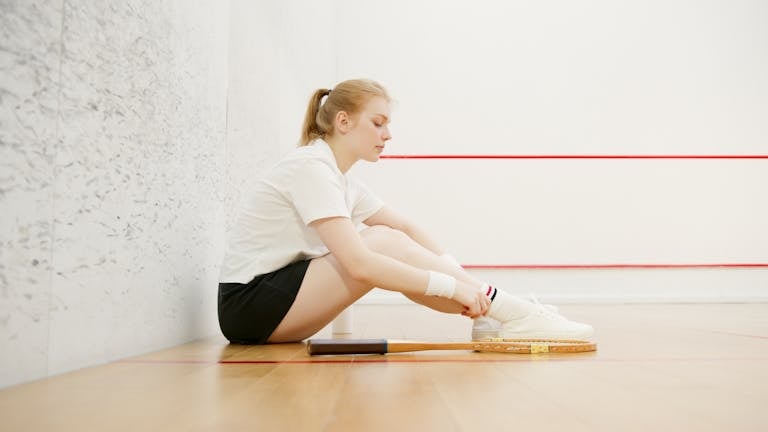Optimal string tension refers to the ideal level of tightness of racquet strings for a player’s game and preferences. In the United States, the optimal string tension for tennis racquets lies mostly in the range of 50 to 60 pounds.
Less tension provides increased power potential and a more comfortable response, whereas more tension aids in improved control and spin. So in environments like LA where the weather is constantly changing, it’s a big factor in string performance.
In addition, extreme heat and dryness make strings lose tension more rapidly. The majority of local stringers and shops around the world default to pounds. They suggest you check your tension every three months.
Choosing the best tension choice is a matter of personal preference, playing level, string type, and frequency of play. The second half explains how to determine which string tension will work best for your game.
What Is Badminton String Tension?

Badminton string tension refers to the amount of tension the strings are strung at across a racket’s frame. This tension greatly affects how a racket feels and how it plays. This aspect strikes a chord with novices and pros alike.
No matter if you’re a beginner or a player that’s on the professional circuit, it really does matter. String tension affects more than just the power or control—it alters the complete racquet feel.
Defining Tension: Pounds vs Kilograms
In the U.S. The rest of the world, badminton string tension is measured in pounds (lbs.) or kilograms (kg). The standard range is anywhere between 18lbs and 34lbs. Most beginners will string low in the 17–20lbs range.
Intermediate players usually prefer 20–24lbs. Advanced clubs typically use 24–27lbs, while pro players start at 27lbs and can increase to 30lbs or more. For every racket, there is a recommended tension, and it is best to follow these recommendations, particularly as a beginner.
If you use plastic shuttles, reduce the tension by 1–2lbs to achieve a more enjoyable feel.
The Basic Physics Involved
String tension has a major impact on the shuttle speed and your control. The softer the string bed, the better. Lower tensions, for example below 24lbs, create a more cushioned string bed.
This bed provides the shuttle a more “trampoline” effect, allowing you to exert less energy for more powerful shots. However, there is a tradeoff. Higher tensions, such as 28lbs and up, minimize this bounce but provide you with a more crisp feel and more precise control.
String the crosses roughly 10% higher than the mains. This fine-tuning locks in racket face alignment and increases torsional stability.
Why It’s Not Just ‘Tightness’
One misconception around tension is that it’s simply the stiffness of the strings. It determines the size and shape of the racket’s sweet spot, how easy on your arm it is, and the power vs control ratio.
Pushing down into the string bed with your thumb can show you what’s really important. If you can push in easily it’s a sign the tension is low. Pros have been using this test forever, but nothing beats the accuracy of a stringing machine, so ideally, measure each time.
Why Correct Tension Is Crucial
Correct tension is key One of the most underrated aspects of racket sports. It is an extremely important part of every single shot you take that affects EVERY shot you take. How you tension your strings affects how you strike, perceive, and even hear the ball.
Selecting correct tension isn’t as simple as going with the current fad. It’s all about getting your equipment in sync with your individual style and distinct requirements. While each player should have their own swing, grip, and play style, that’s why correct tension will be different for everyone.
The Power vs. Control Trade-Off
The power vs. Control trade-off string tension has a huge impact on the power vs. Control trade-off. Lower tension equals greater power. The strings’ trampoline effect causes the strings to deform more upon contact, launching the ball further and with less energy.
Yet power is frequently accompanied by diminished control. High tension provides you with increased control. The ball stays on the strings longer, allowing you to place your shots exactly where you intend. This is done at the expense of power.
This is why pros will frequently adjust their tension based on each match or court surface. If you like to play with a lot of speed and aggression, decreasing tension can make a difference. If you shoot for placement and precision, greater tension yields improved outcomes.
Impact on Shuttle Feel and Touch
What your strings feel like can make or break your entire performance. In general, lower tension tends to produce a more cushy, bouncy feel, which can be beneficial for plushness and shock absorption.
Firm and crisp higher tension is conducive to snapping off sharp, clean shots. Players can generally feel this change immediately—some will like the plushness, while some will want each movement to feel snappy and linear.
Reducing Your Risk of Injury
High or low tension can negatively impact your game in additional ways beyond errant shots. It can be hard on your arm and wrist. Stiff, high-tension strings will only exacerbate injuries such as tennis elbow, and that’s even if you don’t already have a high swing speed.
Lower tension is more forgiving on the arm. It’s great for preventing problems before they happen, particularly with regular players or those coming back from injury.
How Tension Affects Sound
Each tension has a distinctive sound. More tension creates a sharper, clearer “ping.” Less tension has a duller sound. The sound produced can be a good indicator of if your strings are still in tip-top shape or if it’s time to grab yourself a fresh set.
It’s become a go-to for a lot of players because it’s a simple way to test your setup.
Matching Tension To Your Game
String tension is one of those little things in tennis that can have a huge impact in your game. It’s what determines the racket’s “touch,” how the ball will come off the string bed, and the control vs. Power balance a player will have. What is the best tension for your game is not a simple one-size-fits-all answer. That’s all based on how a person plays, their skill level, and even their style of play.
In the U.S., most courts see players using a range of rackets and string types, so matching tension to a person’s game is more about fit than following a rule. This implementation section unpacks what’s successful for various players and why, using plain language and relatable examples.
1. Power Players: Seeking More Pop
Players seeking maximum power with minimum exertion typically gravitate toward lower tensions. Less tension equals more string bed elasticity, or “trampoline effect,” which catapults the ball off the face with added velocity. If you’re playing with polyester strings, optimal tension is between 44-49 lbs. If you use nylon or gut strings, the range increases a little, to 50-55 pounds.
This configuration is advantageous for power players who desire their bullets to soar all the way back to the court. A great example would be a player who spends a lot of time on the baseline. They like to come back from behind and hit big, hard strokes. When I string my racket at 47 pounds with poly, I mean the ball explodes off the strings.
You’ll realize this with more fun and game with less sweat and toil. Many big hitters on Southern California public courts use this setup during weekend matches, finding it helps them drive the ball past their opponents. The flip side of that trade-off, though, is the loss of control. The resulting ball might occasionally sail long if the swing isn’t quite there. Yet, for players who prioritize power, tighter on the low side is the way to go.
2. Control Players: Needing Precision
Players who need to be able to land the ball on a dime often string at higher tensions. The more tension you add, the less the strings want to move. This is because the ball rests on the strings for less time, which in turn makes it easier to anticipate the path the shot will take. For polyester strings, I find 50-54 pounds is a good place to start.
With nylon or gut, this tension increases up to about 56-60 pounds. This is a deadly trap for players who defend with spin, acute angles, or drop shots. A player who likes to carve out angles with topspin and slice just as much will usually have their racket strung at 58 pounds—gut strings at that.
This arrangement allows them to better control the ball within the boundaries. In club matches across Los Angeles, most control players choose more tension in their strings. This decision allows them to lower the ball fast and eliminate more unforced errors. The negative is that it’s harder to create pace, but the reward is improved ball placement.
3. Beginners: Finding a Starting Point
Beginning tennis players can find themselves lost often, and string tension is no different. For the average beginner, the increased control from a higher tension at 54-55 pounds is crucial for development. Nylon or synthetic gut strings in this range will help new players enjoy longer rallies. They teach players positive habits.
That increased precision cuts down on wildly flailing shots and keeps the action flowing. A new player attending their local city’s free tennis clinic may default to a racket strung at 55 pounds with nylon. This allows them to concentrate on hitting the ball hard with great efficiency.
Once players reach a certain skill level, they understand how to calibrate their tension to fit their individual game. The early emphasis should be on developing repeatability, not hunting for strength.
4. Intermediate Players: Refining Feel
Intermediate players have mastered the fundamentals and are looking to refine their craft. This is the group that you’ll find really working to find the right tension to control/power ratio. Hybrid string setups, where you use polyester in the mains and nylon in the crosses, are very popular.
The suggested tension range for them is 46-56 lbs. Usually polyester should be strung 2 pounds looser than nylon to keep an even feel. A regular weekend league competitor who’s an intermediate level player will usually lay up the mains with poly at 48 lbs.
For the crosses, they have nylon for one at 50 pounds. This combination allows them to generate more pace on groundstrokes while maintaining a level of control on serves. Mids should try out various setups and compositions to find what feels most comfortable. This stage is very important, as it’s where personal preferences really start to come out.
5. Advanced Players: Fine-Tuning Performance
Advanced players are intimately familiar with their game and can employ string tension to help them dial in specific aspects. Many professionals in the U.S. Tour scene use tensions around 50-51 pounds for more power, but they often adjust by one or two pounds to suit surface conditions or match strategies.
For example, a tournament player would string 50 pounds of polyester on a slow hard court to increase ball speed. On hot, fast conditions, they might go to 52 pounds for more control. Advanced players pay close attention to string material, sometimes using all-polyester setups for spin or hybrids for a softer feel.
These small changes are what can win points on the biggest stage, where the margin for error is razor thin.
6. Singles vs. Doubles Strategy
In singles, you might prefer a lower tension for more power and spin, as there is room to hit into. In doubles, control and precision become more important, which is why higher tension is more the norm. A 4.0 doubles specialist in Los Angeles might string their racket at 56 pounds with nylon.
This adjustment will help you to keep volleys crisp and improve your net play. In singles, the one player could go down to 50 lbs for more depth and passing shot capability.
7. Understanding Low Tension Perks
The advantages of low string tension give the perk of a softer feel, which is easier on the arm. Players who are feeling elbow pain typically select a tension in the 44-49 pound range for poly strings. Injury-preventers tend to choose 50-55 pounds with nylon strings.
That added flex in the strings absorbs the blow. This change is particularly helpful for more seasoned players and those with a history of arm injuries.
8. Knowing High Tension Advantages
High tension configurations provide increased control and a bright, connected response. Players who value touch tend to go with higher string tension. For polyester strings, they usually select 54 pounds and for gut strings—60 pounds—to ensure their shots stay on the court.
High tension is likewise beneficial in hot playing conditions, which make the ball carry further. It makes the response snappier and makes saving shots more feasible.
How String Choice Affects Tension
Choosing the correct tennis string tension isn’t simply a matter of choosing a number; it’s essential for achieving the right racket performance. The type of string you choose, including modern polyester strings, has a major influence on how your racquet plays and impacts the tension the string will hold. Each string type has different characteristics that play a large part in determining what tension is best for you.
Synthetic Gut: The All-Rounder
Synthetic gut is a mainstay for most recreational players. It’s a popular string for a reason. In the U.S., you’ll find players with their synthetic gut strung in the 50s to 60s lbs (22.5-27 kg).
With lower tension you’ll get more speed and pop, however, the string will move around more and have a less stable, sloppier feel. Increased tension provides a crisper feel and more precision, but it will play stiffer—which is more noticeable in drier/hot climates.
Multifilament Strings: Comfort and Feel
Multifilaments have become the go-to replacement for natural gut and are all about comfort, feel and playability. They’re the softest strings and absorb shock beautifully.
This is a go-to strategy for so many players in Southern California with arm worries. They play with lower tensions, say 50-55 lbs (22.5-25 kg), to ensure a bouncy stringbed that’s hard on the elbow.
Monofilament/Polyester: Durability Focus
Monofilament/Polyester strings are the most commonly used strings by players who frequently break strings. They have great control on high spin and hard hitters, but tend to be stiffer.
23 kg (51 lbs) is the average tension listed here. So what do we suggest for hybrids? Most people lower their tension 2 lbs (1 kg) from what they’d use with nylon for added comfort.
Go any lower, under 22 kg and you start to lose control. Above 26 kg, and the string becomes extremely rigid.
Hybrid Stringing Considerations
Mixing string types—such as using poly for mains and gut for crosses—allows players to combine control and comfort. Tensioning decisions based on which string is in the mains are essential.
Most string the poly 1-2 kg looser for more playability.
String Gauge (Thickness) Matters Too
Lighter gauge (thinner strings) strings stretch more and can increase spin potential, but they break quicker. Playing on thicker strings will give you added durability as well as a more dense, taut string feel.
Thicker strings will produce more tension, but you’ll find yourself adjusting tension less often when playing with thicker strings.
Racket Specs And Tension Needs

Getting the proper tennis string tension is all about your racket specifications and playing style. It’s no longer just the frame; the modern polyester strings also play a critical role. Knowing the specs and matching them with the right string tension can help you hit better shots and get the feel you want.
Frame Stiffness and Tension Synergy
A stiff frame works better with low tension strings, providing the opportunity to reap the benefits of added power and spin. For instance, if your racket is not too flexible, 45-50lbs tension would provide you a dynamic feel.
Softer frames I can string higher tension—over 55lbs—for the fact that the frame is more shock absorbing by nature. This heavier combination provides extra precision, though it can be a bit harsh on your arm.
The takeaway: Plush feeling players tend to choose lower tension with stiff frames to maintain comfort.
Head Size Impact on Feel
Here’s how your racket head size affects tension feel. Oversize heads (100-107 sq in) are more forgiving with tension. 55-60lbs prevents flying long.
Small heads (90-95 sq in) require even less. 50-55lbs is ideal, allowing you to really swing out without sacrificing precision. A good rule: drop a couple of pounds for every 2-3 inch drop in head size.
A dense string pattern might be more forgiving given higher tension.
Manufacturer’s Recommended Tension Range
Manufacturer’s Recommended Tension Range is a smart place to begin. Going significantly out of their recommended range can pose a danger to your frame, or at least ruin the playability.
For example, if your racket says 50-60lbs, going above or below can change how the strings move and how the ball reacts.
Balancing Racket Weight and Tension
Heavier rackets tend to perform best in the higher tensions, ensuring your shots remain consistent. Lighter rackets naturally play better at lower tensions, providing free pop as well as a friendlier feel.
Weather matters as well—cold days will slow down the ball, so a lot of players will drop tension for extra zip.
External Factors Influencing Tension
String tension cannot simply be a matter of personal preference. External factors influence it, and they are subject to swift change. String technology and racket designs have very much improved. Consequently, what was once sufficient for the majority of players is now the bare minimum.
Many players in Los Angeles or other urban spots juggle these factors all year due to changing weather, indoor court setups, or new equipment.
Temperature Swings: Hot vs Cold
Heat causes piano strings to lose tension at an accelerated rate, creating more difficulty in control and a softer feel. Cold has the opposite effect. Tight air causes strings to tighten, and this can make them sound cold and rigid.
In Southern California, where day-to-night swings are common, these changes can significantly alter the situation. A racket strung tight in a cool room will play very loose after a few hours in the sun. The sun’s heat has a drastic impact on string tension.
Many players who use polyester strings reduce their tension by 10%. That’s in part because poly strings are more sensitive to heat than gut or nylon.
Humidity’s Effect on Strings
High humidity causes strings to absorb moisture, which can diminish tension and reduce responsiveness. This is especially true around the coasts or during rainy seasons. Because gut strings are so susceptible to stretching and losing tension in humid conditions, the materials are an important consideration.
In comparison, synthetic strings absorb moisture to a lesser extent. It’s why players should be prepared to adjust tension with the time of year.
Altitude Adjustments (If Applicable)
Altitude adjustments (if applicable) are important to consider. Higher altitudes result in thinner air and a faster shuttlecock. Professionals in places like Denver or Mexico City typically tune their sticks a few pounds tighter.
This allows them to take more control and mitigate the additional speed. Conversely, low-altitude or sea-level actors are able to operate at lower tension with greater power.
Shuttlecock Type Interaction
Feather and synthetic shuttlecock type interact with string tension differently. Feather shuttles require a bit more control, so tension tends to be higher to accommodate this.
Since synthetic shuttles are lighter, lower tension usually provides more power without sacrificing feel.
Finding And Keeping Your Sweet Spot
It’s not just a math game. Finding the perfect string tension is more than just a number on a racquet. For many tennis players, the sweet spot is personal and shaped by how the racket feels in the hand, how the ball comes off the strings, and how the arm responds after hours on the court. Dialing in the proper tension is a nuanced mix of comfort, feel, playability and future arm safety.
This guide walks through the process of finding and keeping that sweet spot. More than anything, it illustrates just how important string tension is to your everyday play.
Start with Recommended Ranges
Almost every racket has a tension range displayed somewhere along the frame (typically in lbs.) This range is a good safe bet for rookie or seasoned players alike. For instance, many rackets suggest string tensions from 50 to 60 lbs. Maintaining adherence to this time window ensures that you will not have any string snapping or frame destruction.
Even within this range, tension increases or decreases can dramatically alter the racket’s feel. The lower the numbers the more pliant the string bed will be. This adjustment can make the sweet spot larger, giving certain players more comfort or power. Increased tension, conversely, stiffens the string bed, usually providing added control.
These changes are not one-size-fits-all. An LA player may want the lower tension of arid California weather to help add some juice to their shots. Conversely, the player from a more humid environment might consider using tighter strings for added control. Begin with the middle of the recommended range. Next, modify according to the feel and the outcome you see.
Experiment: Small Changes Matter
String tension is a fine-tuning process that significantly impacts performance characteristics. It might not sound like much, but even a difference of 1 or 2 pounds can drastically change the feel of a tennis racket. For most people, a 5% decrease in tension is a fantastic starting point. That’s the sweet spot they really want, and it’s much bigger and more forgiving than they think, especially when considering the right string tension for their playing style.
This little dip helps create a more forgiving impact and can improve the feel of mis-hits. It’s typical to lower the crosses—the horizontal tennis strings—by a few pounds from the mains. This one variable change is designed to unlock the sweet spot, which should make the racket more forgiving over a larger area, allowing players to hit with confidence.
Many players even modify the weight of their rackets with lead tape. Adding weight at the 3 and 9 o’clock positions can shift and enlarge the sweet spot to the periphery. Some even tape the 12 o’clock position up on the frame to move the sweet spot higher. These relatively simple fixes are common among club and pro players to customize their rackets to their preferences and ensure the right setup for their game.
The only way to truly know what will work is to experiment with various settings in actual gameplay, considering factors like different types of strings and racket specifications.
Listen to Your Arm and Feel
Listening to your body and finding that feedback to go along with the numbers is equally important. A racket that’s too tightly strung will reverberate painful shockwaves up your arm. Over time, this can cause discomfort or worse, injury. More tension will give your stroke more bite, but less tension will make it a bit softer on impact.
As soon as you begin to feel soreness, listen up! A sudden decline in your performance may be an indication that tension is starting to take a toll on you. Try a few sets at various tensions. Listen to your arm and notice your shots starting to land more uniformly in the court.
Many local players in Southern California report that a slight drop in tension helps them manage long sessions on hard courts, which can be tough on the joints. Caring for your arm isn’t a short-term fix—it’s an investment and string tension is a crucial element in that equation.
Know When Tension Is Wrong
The signs of wrong tension can manifest in a variety of forms. If the ball is launching too high, or if you don’t feel in control, you might not have enough tension. If your photos lack energy, you might be trying too hard to create power. Maybe your strings are a little tight in the tension department for best-sounding play.
This is typically indicative of too much tension. Sudden new pain in the arm, particularly in the elbow or wrist, can also be a sign. The sweet spot can become smaller, leaving the racket less forgiving. These are issues that everyone must address, not just the other player, or the other region.
In climates like LA where outdoor conditions with extreme temperature changes and mostly hard courts can make even slight issues worse, watching for these indicators can save you from bigger problems later on.
How Often Should You Restring?
How often you should restring your racket is largely based on how often you play and what type of string you’re using. As a general rule of thumb, a player who plays consistently three times a week should look to restring his racquet at least three times a year.
Strings lose tension even if they aren’t played on, which is exacerbated in dry/hot climates such as Southern California. Polyester strings, which are very common among serious juniors for their control, lose tension more quickly than natural gut or multifilament strings. If you start sensing a decrease in feel or power, then you know it’s time for some new strings!
Maintaining Tension Over Time
The loss of tennis string tension is inevitable over time, regardless of the string or racket. Factors such as temperature, humidity, and your playing style all play a role. To prevent tension loss, storing your racket away from extreme heat, like a car trunk in the summer, is essential.
To achieve better, more consistent results, some players opt for climate-controlled bags for their tennis equipment. By consistently measuring string tension and fine-tuning it with each restring, you ensure your setup always performs perfectly in the sweet spot.
During each restring, make notes on what tension is most effective and for how long. Over time, this thoughtful documentation helps provide a compass of what to do to keep your sweet spot thriving.
Debunking Common Tension Myths
String tension is one of those topics that’s shrouded in mystery and myth, causing many players to mistakenly search for the “ideal” tennis string tension. On-the-ground experience and scientific studies indicate these assumptions are just plain wrong. Let’s clear up what stands and what falls regarding the right string tension.
Myth: Higher Tension Equals Better Player
Myth #6 – The more tension, the better the player. Research indicates that increasing string tension does not consistently provide greater power or control. For the majority of adult players, a ten-pound increase—from, for example, 45 pounds to 55 pounds—would hardly be detectable.
In fact, some players openly state that they can’t even distinguish between these tensions. Even the most powerful among us demonstrate that a six-pound difference matters. This difference becomes even more pronounced at the high end, particularly when jumping from 61 up to 63 pounds.
Most players will not experience an immediate improvement simply from raising the tension level.
Myth: Factory Strings Are Perfectly Tensioned
A lot of people rely on racquets right out of the box to be perfect. The reality is that factory strings are usually strung to a standard tension, not personalized to the player. For instance, many players feel that going under 45lbs makes them lose power and/or control.
Some players say that it’s almost impossible to serve if you string below 25 pounds. In reality, factory setups don’t account for your own unique swing or playing style, so “one-size-fits-all” just doesn’t cut it.
Myth: Copying Pro Player Tension Works
It’s a common misconception that simply copying a pro player’s tension will do wonders for your game. That’s okay, because pros play with one-of-a-kind styles and one-of-a-kind gear.
After all, what works for Rafael Nadal or Serena Williams may not be the best approach for a weekend recreation league participant. Tension is personal—what works for one person, or even one situation, may not work for another.
Conclusion
Whether you play with a lot of finesse or aggression, getting optimal string tension can help you unlock your full potential. The sweet spot depends on your style, racket, and even the weather. Some people prefer the tighter string tension for extra control on their notes, while others would rather string it looser to get more power.
Playing badminton in the States usually involves countering AC’s presence in the gymnasium or experiencing desert-like conditions outdoors. Both can change your ideal tension. Experiment with a couple different setups, determine what is most comfortable for you, and take detailed notes. Small shops in Los Angeles or Houston are going to be more familiar with their local tarmac, so poke around.
Avoid chasing fads or listening to myths—find what works best for you and go with it. Be vigilant, be observant of the equipment you’re using, and engage in discussions with fellow players about their equipment. Looking for more advice on stringing and setup? Join your local club, or leave a comment below!
Frequently Asked Questions
What is the best string tension for beginners in the US?
For the average beginner, using a tennis racket with a string tension of 18-20 lbs is ideal. This setup provides a larger sweet spot and increased forgiveness, enhancing the overall experience while learning and playing badminton.
How does string tension affect power and control?
Lower tension (18-22 lbs) produces more power and a plusher feel, making it an excellent choice for beginners. In contrast, higher tension (23-27 lbs) offers improved control and accuracy, essential for skilled players aiming to enhance their tennis game.
Does the climate in Los Angeles impact string tension?
Yes. The warm, dry climate of Los Angeles may cause tennis strings to loosen at a faster rate. To maintain your racket’s performance characteristics, check the tennis string tension frequently, especially during the summer months.
How often should I restring my badminton racket?
For frequent players, re-string your tennis racket every 2-3 months. Regular players or those who feel their tennis strings getting loose should restring more often to maintain the right string tension and playability.
Can I use any string type with any tension?
Not necessarily. With softer tennis strings, they frequently break at high tension, such as 60lbs tension. As a general rule, higher tension increases control and decreases power, while lower tension offers more power but less control.
What happens if my tension is too high?
Increased tennis string tension shrinks the sweet spot, creating a less forgiving racket. This high tension can lead to quicker string breakage and may contribute to wrist or arm injuries.
Is professional string tension different from recreational players?
Yes, industry standards lean towards higher tensions (26 lbs and up) for increased control and precision, while countless tennis players find that recreational players typically play better at lower tensions for added power and playability.






